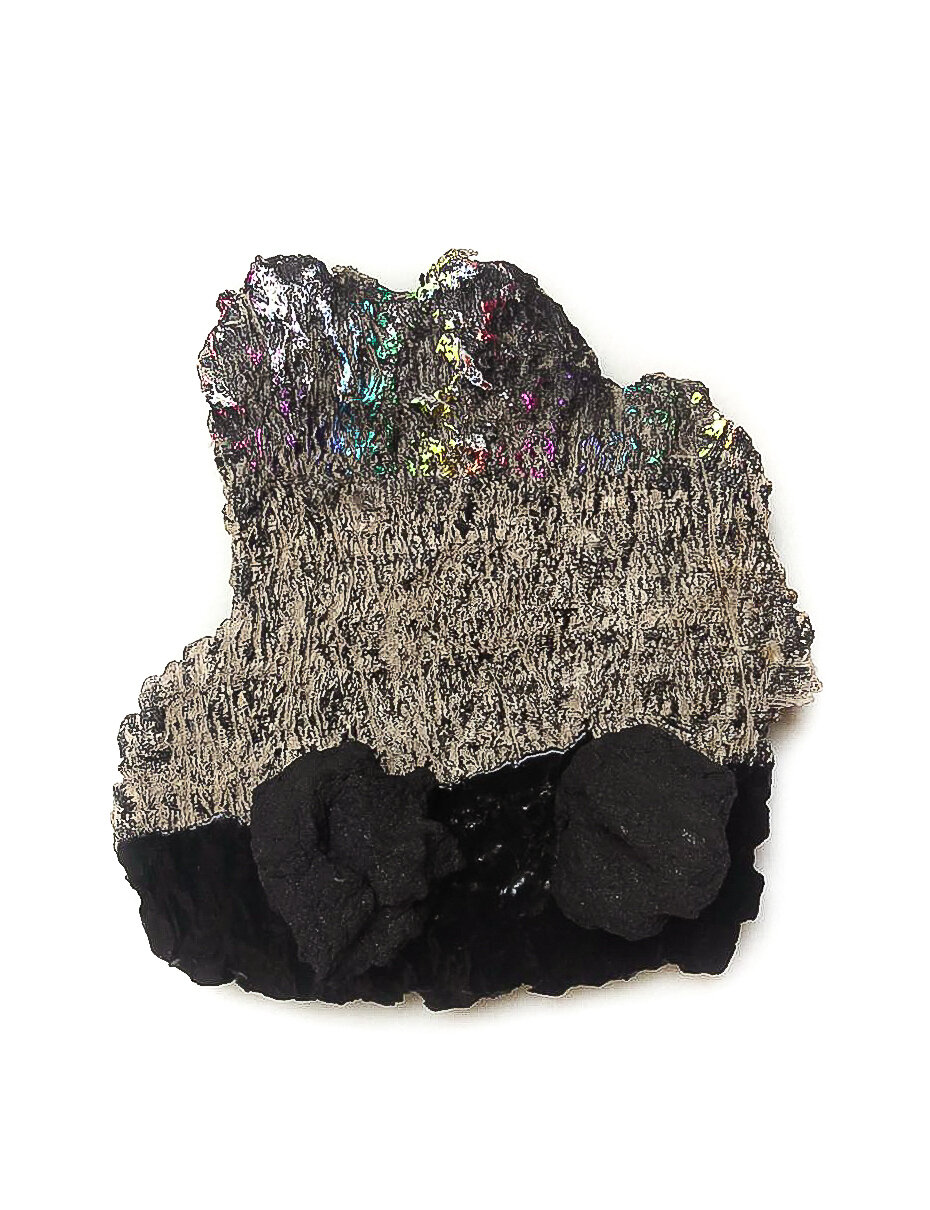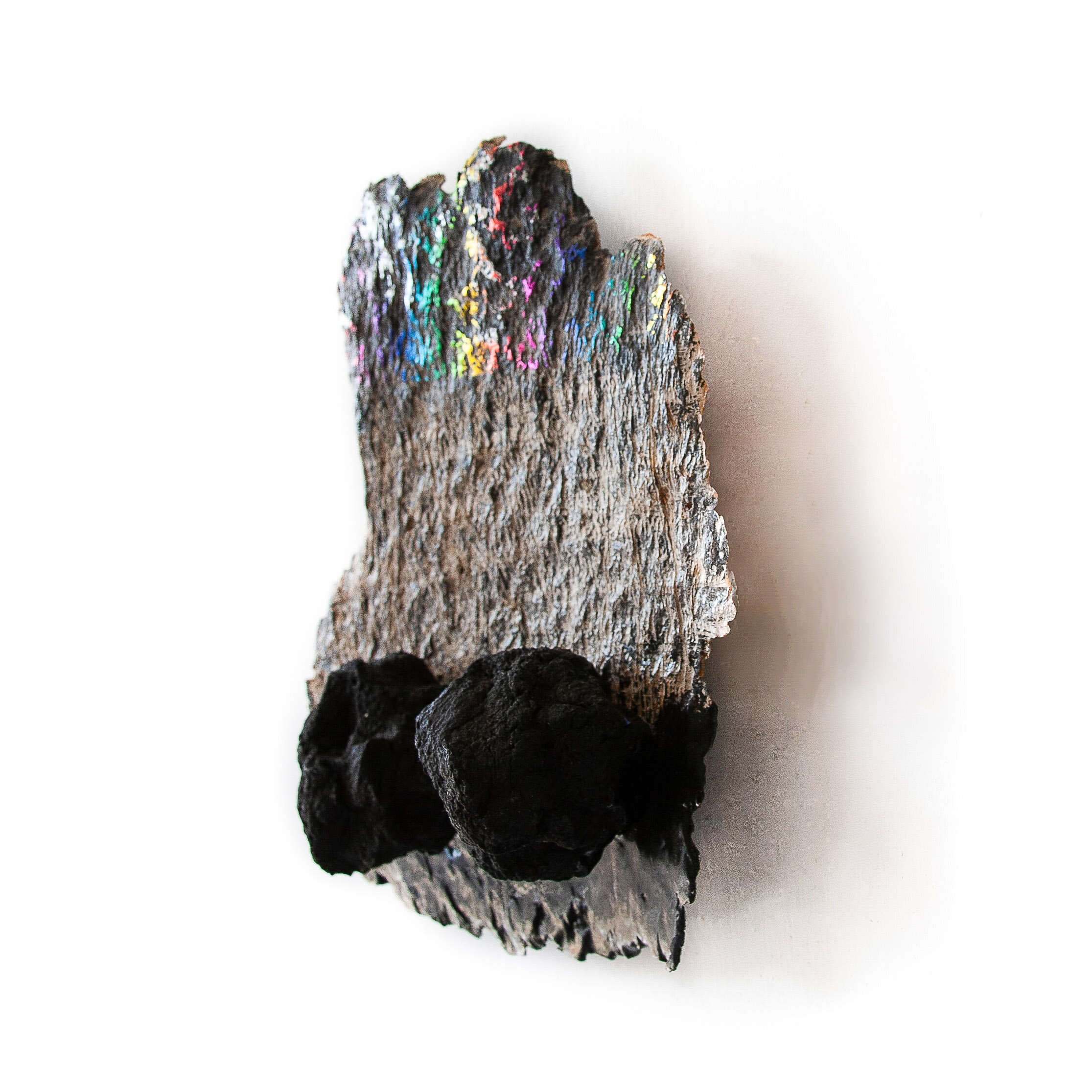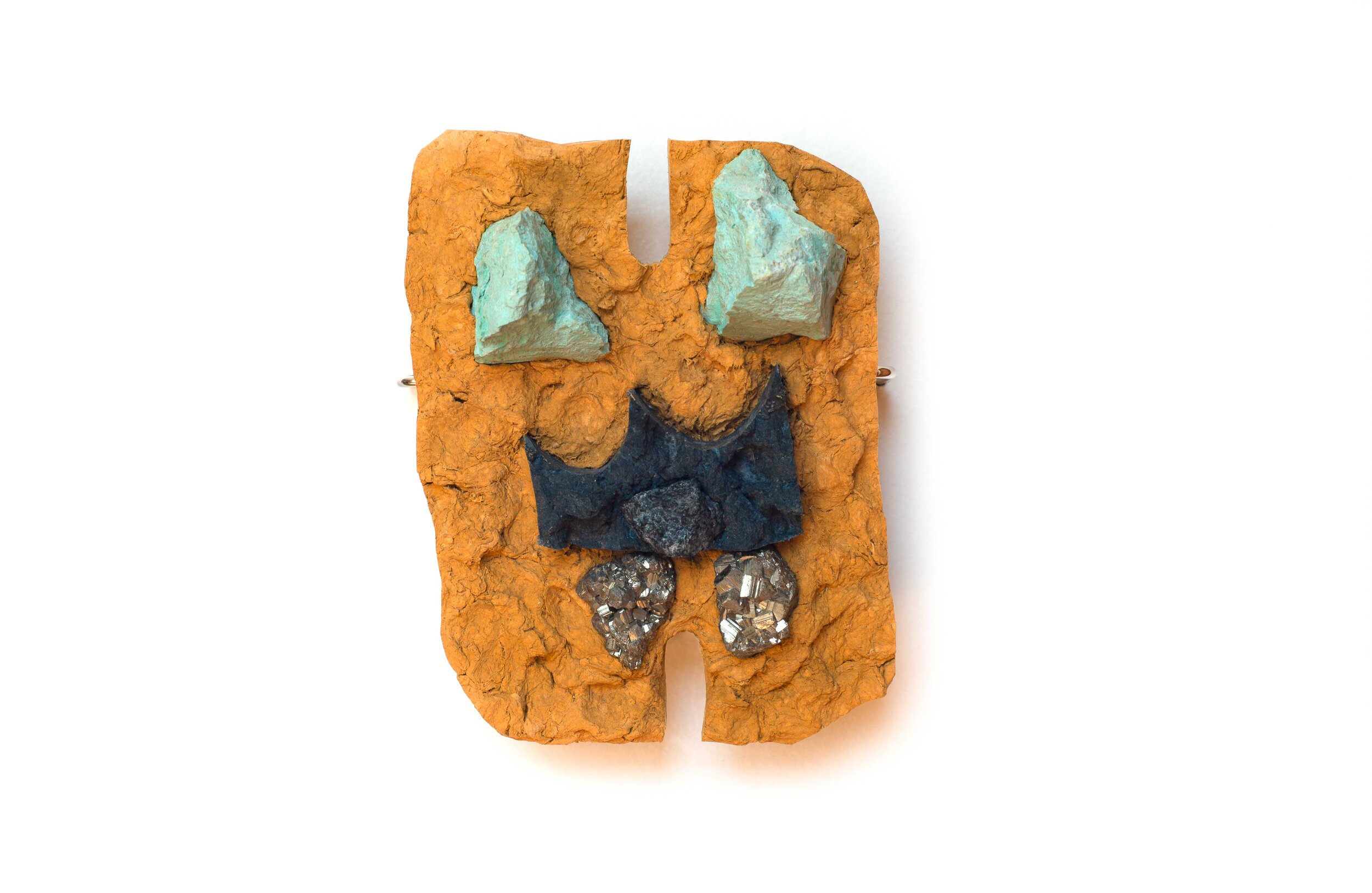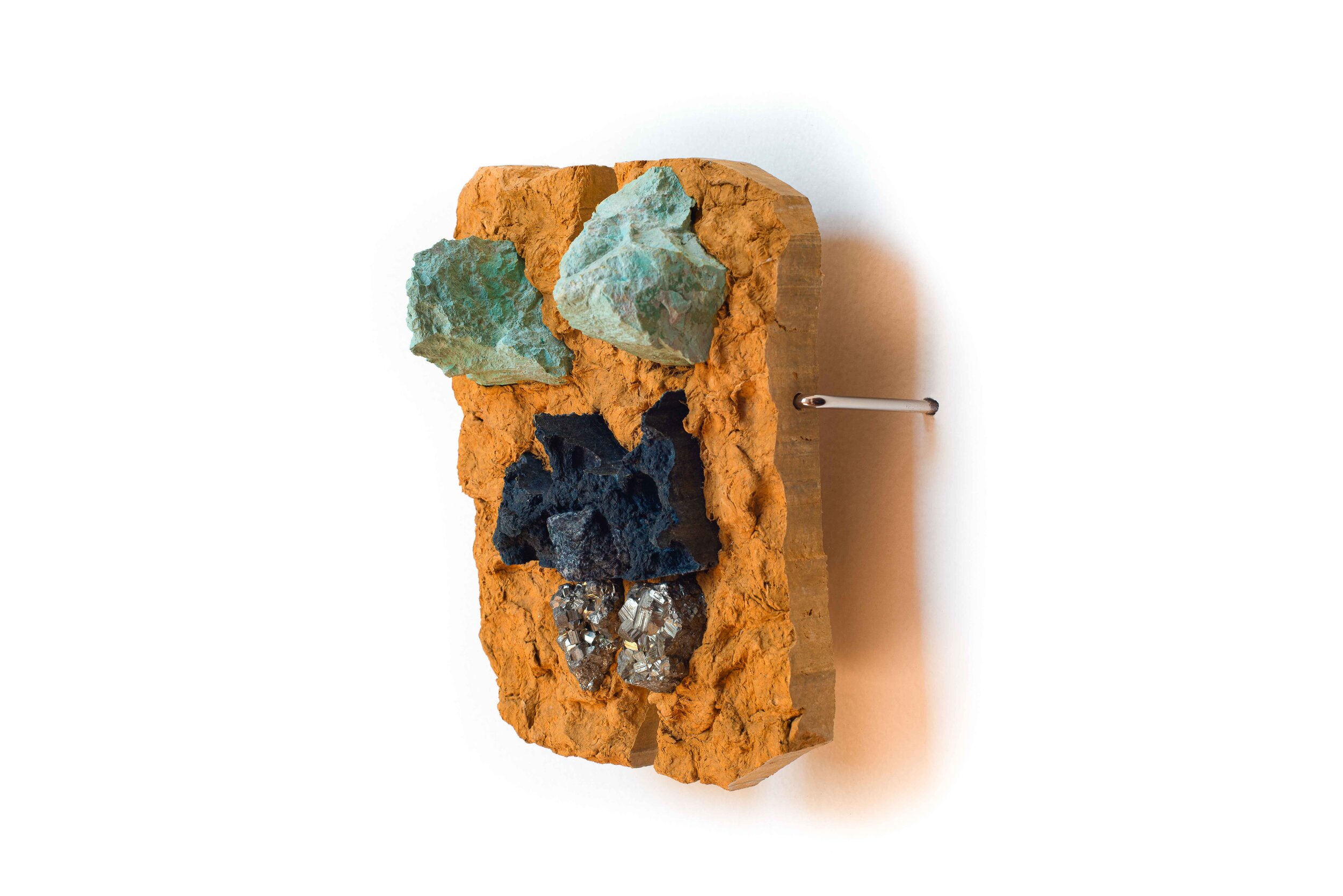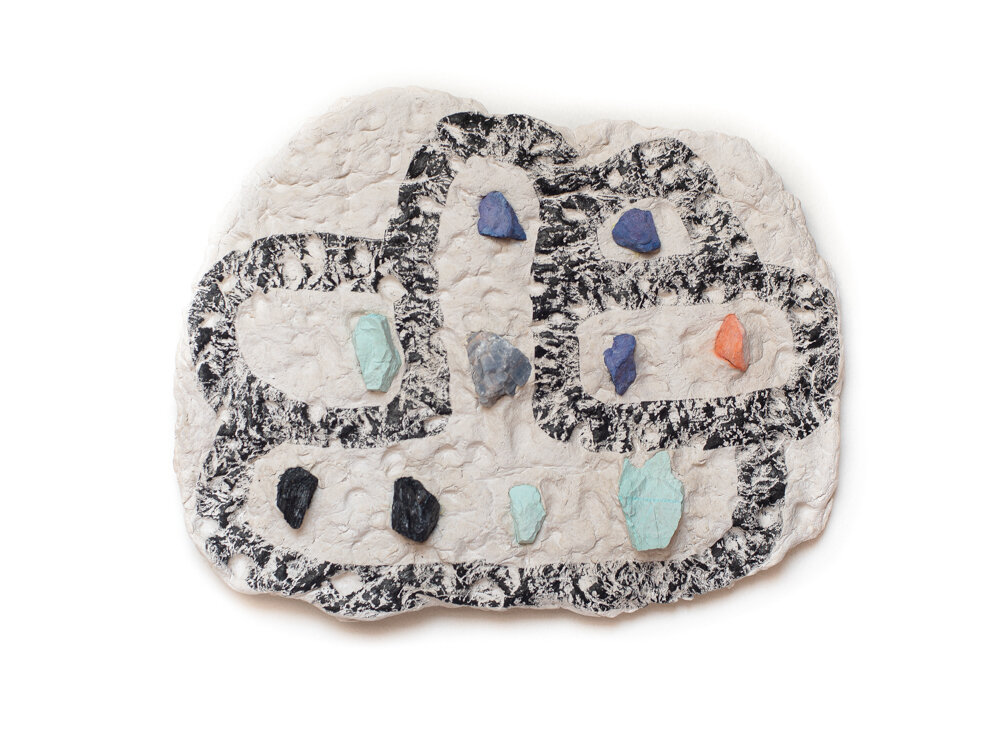Photo of Eleanna Anagnos in her studio.
Spotlight Artist: Eleanna Anagnos
BIO
Eleanna (She/her) (born Evanston, IL) is a Greek-American, New York City/ Mexico City-based artist and curator. Her work sits between painting and sculpture with a focus on haptics, touch, displacement, primal consciousness and bridging the gap between the corporeal and the spiritual.
Eleanna has received awards from Watershed Center for the Ceramic Arts, Newcastle, ME; The Grant Wood Art Colony, Iowa City, IA; The Rauschenberg Foundation Residency, Captiva, FL; Yaddo, Saratoga Springs, NY; BAU Institute at the Camargo Foundation, Cassis, France; The Anderson Ranch, Snowmass, CO; The Atlantic Center for the Arts, New Smyrna Beach, FL ; and The Joan Mitchell Foundation, New York, NY.
Exhibitions include: Monaco, St. Louis, MO; Good Naked, Brooklyn, NY; Tiger Strikes Asteroid, curated by Alex Paik, Brooklyn, NY; NYC solo debut at High Noon Gallery; two-person exhibition at CSPS, Cedar Rapids, IA; solo exhibition at Maharishi University in Fairfield, IA; dOGUMENTA, New York, NY; the SPRING BREAK ART SHOW, New York, NY; Richard and Dolly Maass Gallery, curated by Jennifer Samet, Westchester, NY; 68 Projects, curated by Quan Bao, Berlin, Germany; President Clinton Projects, curated by Sun You, Brooklyn, NY; Die Ausstellungsstrasse, curated by Elsa Koenig, Vienna, Austria; South Bend Museum of Art curated by Betsy Carpenter, South Bend, IN; Galerie Vaclava Spaly, Prague, Czech Republic and the National Hellenic Museum, Chicago, IL. Her work has been featured in The New York Times; Hyperallergic; Maake Magazine; and Artnet, among other publications.
Eleanna has been a Co-Director at Ortega y Gasset Projects, an artist-run, non-profit gallery located in Brooklyn, NY, supporting artists from marginalized and underrepresented communities, for seven years, since 2014. Her curatorial projects have been featured in The New York Times, Art in America, The Brooklyn Rail, and the New York Observer.
She earned her MFA in Painting from the Tyler School of Art and a BA with honors and distinction from Kenyon College with a concentration in Women’s and Gender Studies
ARTIST STATEMENT
There are large gaps between what we know and what we think we know about ourselves and the world around us. How we think and what we believe affects our lived reality. The paradox of the digital age is that we have access to a vast amount of information, more than ever before, and yet, we rarely ask questions. We view the world through a default lens, unable to see the contours or the shape of the lens. I believe in art’s power to inspire questions and offset our default way of thinking. I use haptics, touch, spatial dynamics, color, form, and texture to cut through existing perceptual frameworks and re-contextualize them. I believe our being expands energetically beyond our skin. This idea informs my work where I dissolve boundaries between painting and sculpture. My current works are inspired by my time in Mexico: the retaining walls in contemporary road infrastructure, ancient relief panels with glyphs, and the wall construction of the Pyramids of the Sun and Moon in the ancient city of Teotihuacán, Mexico. By conflating different media using hydrocal, paper pulp, clay, rock specimens, sand, vinyl paint, oil paint, acrylic paint, ink, vermiculite, glass, urethane, fiberglass, pure pigment, and more, I grapple with modes of perception, create paradigm shifts and bridge the gap between the corporeal and the spiritual.
To find out more about Eleanna Anagnos check them out on Instagram or their website.
Interview with Eleanna Anagnos
Cuautla, 2020. Cotton and Linen Fibers, Clay, Rubber, Sumi Ink and Foil. 11 x 10 x 4 inches.
Can you tell us a bit about your background and how you became interested in becoming an artist? What were some early influences? Any stories that stand out in your mind?
I grew up in a bi-lingual and bi-cultural household in Chicago. My grandfather went to the Olympics twice for Greece for basketball and track and field so, when I was 5 years old, becoming an Olympic gymnast seemed like a fairly attainable and reasonable goal to have. Ha ha! I spent a lot of time at gymnastics practice until I had a bad injury at Bella Karoli’s gym in Houston. My mother signed me up for art classes and that’s where my love began. She also took me to the Art Institute of Chicago regularly.
You are currently based in Mexico City after spending 14 years in New York City. What drew you to Mexico? What keeps you there? Are there any aspects of this specific place that have surfaced in your work?
In Mexico paper making is a centuries old practice that is part of the city’s vernacular. Its exponentially growing international art scene, affordability, warmer weather, and vast cultural heritage (there are over 200 museums in Mexico City alone) were all good reasons to consider it as a new home base. Of the reasons to stay, two stand out: the time and space to make my work, and to be with my partner who is from Mexico City. What I’ve really grown to understand about my practice is that I absorb my context and location and transfer those experiences through my body into the work. My work changes depending on where it’s made—there’s a site-specificity that way. Mexico is in all of the work that I’ve made while living there, physically, symbolically, metaphorically and spiritually.
Nightfall, 2021. Handprocessed Indigenous Amate Fibers, Clay, Bisqued Oaxaca mud, Rock specimens and Pure pigments. 18.5x19 x 2.5 inches.
What is the art scene like in Mexico City? After spending so much time in NYC, are there any interesting comparisons?
It’s growing. It’s not NYC, of course, what else is? However, it is a place where discourse is central to the work and community. There is a focus on conceptual art.
You have a lovely studio! I love the patterned tile floor—it gives the space a funky, warm, and welcoming vibe. Can you tell us more about your space? What are some of the most crucial aspects of the studio that make it suitable for you? What tools, materials, supplies are must-haves?
My studio has been an incredibly safe space for me. It is perhaps the smallest studio I’ve had but it’s on the roof of my apartment building. It is private, with beaming light streaming in. The space was originally built as a nanny’s quarters but most people these days use their spaces for storage. There are also outdoor cages for each apartment to hang laundry. I use this cage as an extended space to dry the work in the sun. I have built narrow shelves that display rocks, paper rocks, paper chunks cut off from other works, and salvaged coral.
Sacrament Stones, 2021. Handprocessed Indigenous Amate Fibers, Clay, Pure pigments, Rock specimens and two Hex wrenches. 9 x 7 x 6 inches.
What is a typical day like?
I wake up, have a cup of warm water and lime. Then I practice the Sudarshran Kriya (a breathing technique I’ve been practicing for 18 years). And then I practice Transcendental Meditation. After that I eat breakfast, I reply to emails and go to the studio upstairs.
What gets you in a creative groove?
Working with materials I’ve never used before. Not being precious about the materials: Play. When I go into the studio thinking: “I’m going to go in there and f*ck sh*t up”, I release pressure about making something good, great or precious. It opens up the practice for me.
What puts a damper on your groove?
Planning the painting as an architect would plan a building- it comes from an insecure place and kills the magic.
You currently work primarily with paper pulp. What excites you about this material? What are some of the attributes that make it either a challenge or a joy to work with?
Yes, I primarily work with paper-pulp. It is an incredibly dynamic medium. Paper pulp can be opaque or transparent, more unwieldy or stable, depending on what type of fiber one uses, or how long it’s beaten. Paper can be recycled or upcycled. Paper is quotidian and recognizable, yet it shifts with different processes, evoking skin, concrete, or blobs of paint. It’s full of inherent contradictions and metaphorical implications. The dynamism of this medium makes it so fun to work with. It doesn’t come easily though. I think of my work as a collaboration with the pulp and me. I am on its time and it requires me to relinquish control and let it do it’s thing.
Where the Spirit Meets the Bone (Hugging the Line), 2020. Cotton and Linen Fibers, Clay, Rock Specimens, Pure pigments, Urethane, and Oil paint. 20 x 24 x 4.5 inches.
I know that your process is really labor intensive! Without giving away any proprietary secrets, can you give us a glimpse of what it takes to create one of your paintings?
First I order the paper fibers and request the length of time I want it beaten. Then I color the pigment using a chemical process and then I mix other ingredients into the paper to strengthen it. Then I manipulate it and often cut into it using a specialized saw. I also use digital processes to make the work as well- turning a line drawing into a 3 dimensional form. Working with pulp fibers the way I do is a lengthy, arduous, labor intensive process but I love it.
You are currently a co-director of Ortega y Gasset Projects in Brooklyn, and have been involved in that organization for a long time, often in the role of curator. How does this role relate to your practice as an artist?
Working at OyG has been an extraordinary experience which has taught me and given me so much. Since I began curating, I think much more about works in conversation with other works rather than focusing all of my attention on a singular work. I’m also much more aware of what it takes to support artists. It’s given me a greater appreciation of the time and talent the professionals I work with give. I try to be respectful of them by having my sh*t together and responding in a timely manner.
Over time you have attended numerous residencies and fellowships—recently you were an artist-in-residence at the The Rauschenberg Residency, and a Grant Wood Colony artist fellow. How have these experiences affected your practice, work, or community?
The residencies have been instrumental to my development as an artist. The time, space, support has allowed me to grow in ways I simply couldn't have done at home with all of life’s distractions. The interactions with artists mastering other genres has informed my work as well. I have a deep respect for what they do. It’s comforting and sustaining to realize you are part of a larger network of creators, who quietly work out of sight from the public eye, honing their craft over a long period of time.
Communion (Hugging the Line), 2020. Cotton and Linen Fiber Fix, Rock Specimens, Pure Pigments and Sumi Ink. 14 x 18 x 2 inches.
The pandemic has created numerous challenges for artists. Have you experienced any particular roadblocks or changes during this time that have affected you or your practice? Any unexpected benefits or the appearance of a silver lining?
Many good things came from the pandemic as it relates to my work. For the first time in my life, beyond school or a residency, I made artwork consistently full time. The benefits have been extraordinarily, felt and seen in the work.
I stayed in Mexico, initially because of the pandemic which enabled me to afford a private light filled studio and an assistant. What’s hitting me now are the challenges—namely, the isolation. I live in a country where I have hardly left the confines of my home or studio since I moved here, so I have few friends and don’t speak the native language. That’s tough, but things I can work on now that interactions are becoming more normalized.
Are there any contemporary artists you’re currently really excited about?
Lately, I’m excited by the work of: Lynda Benglis, Susan Frecon, Raoul de Kaiser, Masaomi Yasunaga, and Sterling Ruby.
Do you have any tips, tools, resources, or advice that someone has shared with you that you have found particularly helpful?
In 2006 Pat Steir told me to “leave the judge at the studio door.” That was immensely helpful as a young artist.
What’s up next for you?
My catalog will be released soon with an essay by artist, curator and writer, David-Ayala-Alfonso. I’m in conversation with Fawn Krieger in BOMB Magazine which published this week! I will be presenting work at Material Art Fair in the Spring of 2023. In the Fall of 2023 I have a two-person exhibition with Alexis Granwell, curated by London-based, Tally de Orellana at the Amelie A. Wallace Gallery at SUNY College Old Westbury on Long Island. It’s a 2500 square foot space. We are thrilled to exhibit our work in a large institutional venue.
Anything else you would like to share?
Come visit Mexico City!
Embrace (Hugging the Line), 2020. Cotton and Linen Fiber Mix, Rock Specimens, Pure Pigments and Sumi Ink. 18.5 x 18 x 3 inches.


